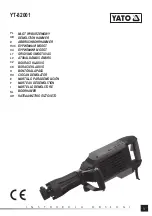
Maintenance
Page 11
S
Disconnect the tractor PTO or power
supply before performing any operation
on the pump.
Oil
The level and condition of oil should be
frequently checked (eg. each time the tank is
filled) as it effects the operation of the pump
and the condition and life of the diaphragm. It
is advised to replace the oil every 300 hours
of work or annually, whichever occurs first
and at anytime the diaphragms are replaced.
Oil Level
When the pump is stationary the oil level must
correspond to the reference indicator found on
the oil sight glass (fig 2) or oil level cap (fig 1)
depending on the type of pump. The oil level
may vary when the diaphragm pump is
working: As the pump is started the oil level
will initially drop and then return to functioning
level when the liquid begins to pump.
During operation pay attention to any drop in
the oil level:
a) If this happens during the first few hours of
operation it is normal and it is sufficient to top
up with SAE 20W/30 type oil as in fig. 1. For
pumps BP 60/20 and P48 where the oil sight
glass is not present, remove the pressure
accumulator assembly (fig 3). When
remounting the manifold tighten the
connecting plate screws to a torque of 17 Nm
b) If this happens after many hours of
operation and continues after 1 or 2 top ups, it
is a symptom of diaphragm swelling caused
by restricted suction (dirty filter, collapsed
suction hose or chemical attack to
diaphragm). In this case check the filter and
suction system and/or refer to your Silvan
dealer to check the diaphragm.
Diaphragm Failure
If the oil becomes white (water present in oil),
it may be a symptom of breakage of one or
more diaphragms. It is necessary to stop work
and inspect the condition of the diaphragms.
If broken, it is necessary to replace the
complete set.
Continued use with water in the oil will cause
serious damage to internal parts of the pump
If it is not possible to replace broken
diaphragms within one day of failure, empty
the crankcase of water and pour in oil or
diesel oil to stop rust from forming on the
internal components.
Suction
The suction system must be inspected to
ensure:
1. There are no suction air leaks. Check for
entry of air caused by:
- entry of air caused by hose wear;
- loose fittings;
- worn joints;
2. There are no small leaks or drips when the
pump is stationary. If this occurs it means air
will enter the pump when in operation.
3. The filter is be kept clean with frequent
inspections (after every tank load) especially if
powder based products are used.
Pump Mounting
Periodically check, especially when there is
vibration during use that the pump mounting
bolts on the machine frame are tightened and
if necessary re-tighten.
Pressure Accumulator
Check the inflation of the pressure
accumulator, if fitted, according to Table A
especially if there are vibrations on the
delivery hose and/or the pressure gauge.
Freezing Conditions
If frosts or freezing conditions are likely to
occur then drain all water from the pump to
ensure the pump is not damaged by freezing
water expanding inside the pump.
Diaphragm Replacement
At the end of every season it is advised to
check the condition of the diaphragms and
replace if worn or distorted. If the pump heads
and/or diaphragms are removed the retaining
bolts should re-tensioned according to the
Silvan Torque Specifications chart.
Inlet and Outlet Valves
Periodically check (every 300 hours under
normal working conditions) the condition of
the inlet and outlet valves. The check must
be more frequent if sandy liquid or abrasive
liquids are used. They must also be carried
out if changes of pressure, irregular
functioning and strange noises are apparent.


































